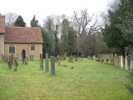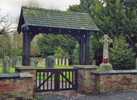For this church:    |
Bleasby St MaryChurchyard
St Mary’s church is set within a large quintessentially English churchyard. A low red brick wall topped with Staffordshire Hog-back copings runs parallel to the village main street, to enclose the north side, whilst the eastern boundary is formed by fencing and hedging of various types. A deep ditch with steep sides secures the northern perimeter. To the west the walling is the same as that on the street for part of its length to the point where it is almost level with the tower here the wall turns north to two enclose two extensions to the burial area. The older of the two extensions dates from the 1950s and is again contained by a low brick wall, which runs west but unlike the north wall it is topped by half round limestone coping, a gap in the wall gives access to the second extension, created in 1996, that in 2010 has just only five burials and a few remembrance plaques dating from about 2004. The west boundary in this area is a post and rail fence. A gate near the junction of the west wall and the north boundary of the new burial area gives access to an old pathway which leads to a small bridge over the ditch and into the grounds of the former vicarage. On the left side of the pathway between the street and the south porch is a magnificent cedar tree with branches that cover most of that part of the churchyard. There are also several fine yew trees. The ground is well maintained with several other good specimens of trees and shrubs.
Access to the main churchyard is through a lychgate set opposite the south porch the main entrance to the church. The timbers of the lytchgate frame rise from red brick pillars with flat stone cappings. The wood-work is oak and the roof covering is dark flat clay tiles on which a layer of moss creates a sense of antiquity – it was however installed in 1848 by the Allen family. Located on the right a few yards along the stone path is the village War Memorial.
The churchyard contains a typical range of grave markers and memorials as would be expected of a site of its age. It also boasts a number of table tombs. Many of the inscriptions on the markers on the west and south sides are no longer legible, but a survey and record was made of the inscriptions in the 1970s. The oldest readable marker is that of Elizabeth Kitchen who died in 1677. Several former incumbents have been interred within the churchyard and on the north side is a red granite memorial to the Rev Nathaniel Midwinter who died in 1898 at the age of 71. It records his thirteen years in residence and his previous service of thirty years as Reader of St Michael’s Winchester. Significant MemorialThere is a memorial tablet lying near the east window which was removed from the church in 1816. It commemorates two former vicars, John Sheepshanke, died 1639, and Simon Sachell, died 1658. The inscription records that they shared office, work, death and grave, but it does not mention that they also shared one wife, Margaret Sheepshanke, widow of John Sheepshanke, marrying Simon Sachell in 1640. And Henry Williams, writing in 1890, says of it: Simon Sachell died in 1658, and the stone covering his grave and that of his predecessor, John Sheepshanke, has the following inscription:
Is it too far fetched to suppose that in this touching epitaph the connection between Bleasby and Blisse may be just hinted at – Bleasby now. Blisse by and bye. |








